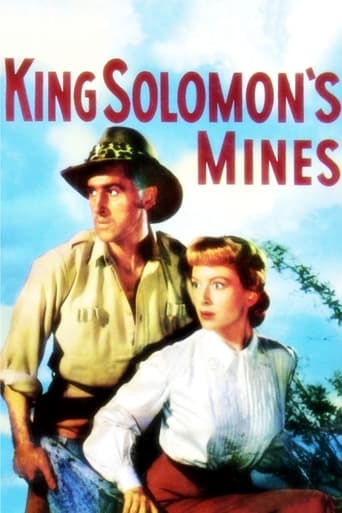Edgar Allan Pooh
. . . did not start in the 21st Century. KING SOLOMON'S MINES, a 1950 flick, documents that the Watusi Clique was resolving such disputes at least as early as the 1800s through their gyrations on the dance floor. While the two contestants making up the final pairing here may be wielding some sort of flimsy ceremonial "spears" not unlike the artifacts used during the Olympic "sport" of rhythmic gymnastics, the only implied scoring move apparently came out so lame in every "take" that it was cut from the final print of this film for being too trivial of a detail to include. Overall, the choreography of KING SOLOMON'S MINES leaves a lot of room for improvement. Featuring repetitious drumming, drab and hot-looking bulky costumes, as well as stiff almost geriatric "moves," these period movers and shakers would not make it out of the preliminary round of any present-day competition. However, since KING SOLOMON'S MINES also features the very real-looking extermination of many of Today's endangered or extinct critters of Africa (where this flick was shot), it's liable to hold a lot of historical interest for Wildlife lovers.
romanorum1
The setting: East Africa, 1897. Macho safari guide and hunter Alan Quatermain (Stewart Granger), offered a generous down payment of five thousand pounds, reluctantly decides to assist Elizabeth Curtis (Deborah Kerr) in finding her missing husband. But Quatermain is not confident that a woman can undertake what will be a perilous journey into the interior. Mr. Curtis had left his home several years earlier in order to find King Solomon's diamond mines in darkest (uncharted) Africa. Why Mrs. Curtis wants to find him is that she takes on some responsibility because of her less-than-decent treatment of him. She tells Quatermain that she is independently wealthy, unlike her husband, and that she still loves him (!). She even has a hand-drawn map of Curtis' trek. Yet these types of movies, where the wife is trying to find her long-lost beau, send a signal that you just know the missing dude isn't going to be worth it. So the movie develops into a love story between the two leads. Accompanying the two is Mrs. Curtis' loyal brother John (Richard Carlson). A key player is seven-foot tall and lean Umbopa (Siriaque) of the Watusi tribe. After fifty minutes of the movie have passed, he joins the expedition out of nowhere. Unassuming for most of the film's remainder, he has a significant moment at the end. By the way, the indigenous cultures are treated with deference, and the natives get significant screen time.We see many wonderful wild animals, including elephants, rhinos, lions, and leopards. But the expedition is fraught with all kinds of difficult situations: dangerous snakes (black Mamba, cobra, and others), an unfriendly native tribe, and a massive stampede of zebras, giraffes and gazelles. Then there are unpredictable bearers who later desert, stealing much of the supplies. Despite the setting of the story, it is nice to see that our hero Quatermain shuns the indiscriminate shooting of animals. Africa is a beautiful place, but one has to be tough to live there. After learning about the fate of Curtis, our heroes are trapped in a cave-mine without food. At the denouement there is an exciting three-minute duel between two men: a usurper of the tribal throne and the legitimate king. This clash really is not much different than that of a USA western setting with two dudes fighting it out, one good and one bad. If the bad guy wins, then it will be an undesirable ending for the few survivors of the expedition.This movie is an enjoyable adventure story with tense situations, and is nicely edited and acted throughout. Although Deborah Kerr is often frightened and has nightmares, remember that she is supposed to be proper and unsuspecting of a safari's hardships. The photography is magnificent! On-location shooting is always a plus, even if supplemented by such places as California and New Mexico. But there is no stock footage in this feature! Yes, Africa is the real star. In its day the film must have been a real eye-opener.
ncmike1
It's Quatermain, not Quartermain. I had just finished reading the book, and the film doesn't follow it at all except in a very few places. However, the film still stands out as a good adventure, with excellent photography and views of Africa not seen before including the animals and the natives. Wonderful for its time, I guess, but doesn't really hold up for today's audiences. I still enjoyed it for what it is. The stampede scene was, however, pretty darn good. I have no idea how they got that to happen especially with so many different kinds of animals. What made me laugh, though, was the giant spider. It was so fake. And why was it even called King Soloman's Mines? They spent about 1 minute looking at the gems, and then went on with the unrelated story. Overall, it was just OK.
dougdoepke
I remember the movie played in our little town's premier theatre to considerable fanfare— See Darkest Africa As It Really Is in Dramatic Technicolor!— you know, that sort of thing. In fact it was a treat to see all the wild animals and fearsome natives, plus an exciting adventure story. I expect MGM made back its expenses and then some.Of course, that was before TV brought the world into living rooms everywhere. The movie may have lost that long ago novelty, but it's still a good story set in what was then colonial Africa, with a first-rate cast, including the exotic Umbopa, the prince in exile. Then there's that thundering stampede whose mighty numbers still impress.Like many reviewers, I cringe now at the elephant kill. I'm sure I didn't at the time, but then this ecological type change reflects a newer awareness, and one I think for the better. Actually, Quartermain (Stewart) is also bothered by big game kills, one reason he's ready to give up his hunting safaris.Happily, Stewart's persuasive as the experienced white man, while Kerr does nicely as the British gentlewoman able to adapt her well-bred ways. (However, MGM, ever the glamour studio, refuses to de-glamorize her no matter how rough the going). I do feel a little sorry for tag-along John (Carlson) who, nevertheless, hangs in there. On the other hand, I'm still curious about the van Brun (Haas) role. Was that episode in the book or was it added to diversify and perhaps pad the storyline.No, those old promotionals about Africa in Color wouldn't work now. But the movie's still an eyeful with a good adventure yarn and a fine cast, and those are film features that do endure.







